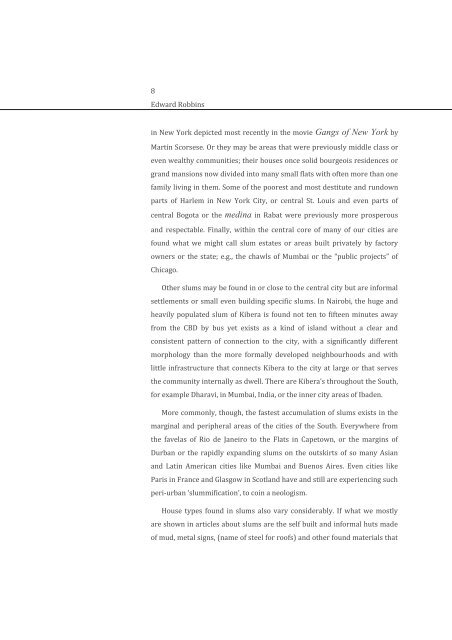SOME THOUGHTS ABOUT SCARCITY - SCIBE
SOME THOUGHTS ABOUT SCARCITY - SCIBE
SOME THOUGHTS ABOUT SCARCITY - SCIBE
You also want an ePaper? Increase the reach of your titles
YUMPU automatically turns print PDFs into web optimized ePapers that Google loves.
8<br />
Edward Robbins<br />
in New York depicted most recently in the movie Gangs of New York by<br />
Martin Scorsese. Or they may be areas that were previously middle class or<br />
even wealthy communities; their houses once solid bourgeois residences or<br />
grand mansions now divided into many small flats with often more than one<br />
family living in them. Some of the poorest and most destitute and rundown<br />
parts of Harlem in New York City, or central St. Louis and even parts of<br />
central Bogota or the medina in Rabat were previously more prosperous<br />
and respectable. Finally, within the central core of many of our cities are<br />
found what we might call slum estates or areas built privately by factory<br />
owners or the state; e.g., the chawls of Mumbai or the “public projects” of<br />
Chicago.<br />
Other slums may be found in or close to the central city but are informal<br />
settlements or small even building specific slums. In Nairobi, the huge and<br />
heavily populated slum of Kibera is found not ten to fifteen minutes away<br />
from the CBD by bus yet exists as a kind of island without a clear and<br />
consistent pattern of connection to the city, with a significantly different<br />
morphology than the more formally developed neighbourhoods and with<br />
little infrastructure that connects Kibera to the city at large or that serves<br />
the community internally as dwell. There are Kibera’s throughout the South,<br />
for example Dharavi, in Mumbai, India, or the inner city areas of Ibaden.<br />
More commonly, though, the fastest accumulation of slums exists in the<br />
marginal and peripheral areas of the cities of the South. Everywhere from<br />
the favelas of Rio de Janeiro to the Flats in Capetown, or the margins of<br />
Durban or the rapidly expanding slums on the outskirts of so many Asian<br />
and Latin American cities like Mumbai and Buenos Aires. Even cities like<br />
Paris in France and Glasgow in Scotland have and still are experiencing such<br />
peri-urban ‘slummification’, to coin a neologism.<br />
House types found in slums also vary considerably. If what we mostly<br />
are shown in articles about slums are the self built and informal huts made<br />
of mud, metal signs, (name of steel for roofs) and other found materials that




